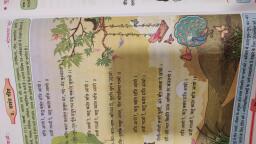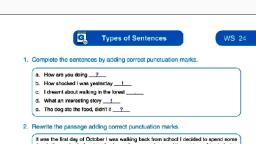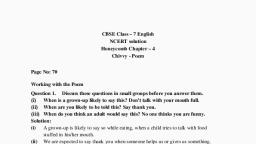Page 1 :
3.4 Please don’t read this poem!, , Kenn Nesbitt is a children’s poet. He writes, humorous poems. They express children’s, feelings and experiences., , Ordinarily, all authors want people to read, their literature. But funnily, the author of this, poem keeps on warning the reader NOT to read, his poem. The warnings have just the opposite, effect. You are tempted even more to read the, , poem., , , , * Have you ever been told not to do certain, Mia : Please don't, , bark so |oudly., Toto : Please don't, give me instructions., , things? Did you stop doing that immediately?, , Or did you continue to do same any way?, , Make a list of your ‘don’ts in groups of five, discuss, the list and complete the following table., , , , , , Paddy : Don't watch List of Stopped Tried it /, , so much TV. Don’ts doing it Did it anyway, ese cate, , Bittu : Don't eat y AT ee, , junk food. 3, , Kuku : Don't use, fairness Creams., , , , , , , , , , * When you write something, or paint something,, or make something, do you want others to see it?, , Discuss the reasons for your answer., , , , 73
Page 3 :
And all because YOU read this, , j i un., instead OF having Fur, It’s too late now, amigos, , *he poem’s nearly done., , ’s only one sojution. ;, ae "11 nave tO do :, , j d family, , e\| all your friends an |, ph shouldn't read it too. ,, , - Kenn Nesbitt, , , , e cop: policemen’ e frail: weak e amigo: friend, , , , 1. Present any two stanzas of the poem using proper intonation., , 2. Find the pairs of rhyming words used in each stanza., , 3. Think and answer :, , (a) The poet is telling someone not to read the poem. Who is that someone’?, (b) What did you feel when you read the line ‘Please don’t read this poem’?, (c) Does the poet really want you to stop reading the poem?, , (d) What does the poet mean when he says, “Tell all your friends and family they, shouldn’t read it too.”, , (ce) What situation the following lines remind you of ‘Put the poem down now and slowly back away’., , Decide whether the following things are right or wrong., Give reasons for your answer :, , (a) Reading someone else’s letter, , (b) Reading someone else’s diary, , (c) Looking at the keyboard when someone is typing a password., , (d) Eavesdropping - Listening to other people’s conversation without their, knowledge., , (ec) Trying to get someone’s address, phone number, email ID without their, knowledge., , ‘Please Don’t Read This Poem’ copyright © 2012 Kenn Nesbitt. All rights reserved., Reprinted by the permission of the author., , 75
Page 4 :
5. Read the lines given in the table. Discuss what they mean and when they, might be used. Then use your imagination and name situations which, these lines may be used by different speaker., , , , , , , , Lines Situation Speaker, 7 -, * Just move along People gathering to A friend of the two, now. There’s nothing| watcha fight between | brothers, who is trying, here to see. two brothers. to stop the fight tells the, , people., , * I’ve asked you once, politely., , Don’t make me ask, you twice., , , , * This isn’t yours,, it’s mine., , +, , , , * Ifyou don’t quit this, instant, I swear I'll, call a cop., , , , * Itis too late now., , , , * Here’s what you’ll, have to do., , , , , , , , , , , , 6. Add one or two lines before or after the lines given below to prepare a short dialogue., , e It’s only meant for me. e That isn’t very nice., e You really have to stop. e There’s only one solution., 7. Find all contracted forms used in the poem. ol st, , , , ea, KYSSFT, , , , , , , , , , , , , , , , , , , , , , Questions with ‘be’ and ‘have’, The auxiliary verbs ‘be’ and ‘have’ form questions without the help of ‘do’., Be Have, e Are you writing a story? 7s e Have I made a mistake?, es/No : ., i ' : H tten this?, e Is she going home? questions e rave you written this, e Were they reading their e Has he given you a book?, homework?, e Where are you going? e What have you drawn?, e What is she painting? questions e Why has he come?, . * Why are you laughing ? — e Where have you put it?, , , , 76, , > = h6UmrTrhTCVG mt vee , ye













































